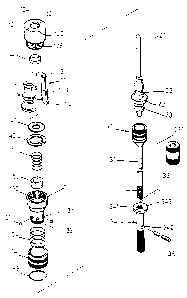Some of the information on this Web page has been provided by external sources. The Government of Canada is not responsible for the accuracy, reliability or currency of the information supplied by external sources. Users wishing to rely upon this information should consult directly with the source of the information. Content provided by external sources is not subject to official languages, privacy and accessibility requirements.
Any discrepancies in the text and image of the Claims and Abstract are due to differing posting times. Text of the Claims and Abstract are posted:
| (12) Patent Application: | (11) CA 2420692 |
|---|---|
| (54) English Title: | GEAR PULLER HAVING OUTWARDLY FORCED JAWS |
| (54) French Title: | EXTRACTEUR DE PIGNONS COMPRENANT DES MACHOIRES A PRESSION FORCEE VERS L'EXTERIEUR |
| Status: | Deemed Abandoned and Beyond the Period of Reinstatement - Pending Response to Notice of Disregarded Communication |
| (51) International Patent Classification (IPC): |
|
|---|---|
| (72) Inventors : |
|
| (73) Owners : |
|
| (71) Applicants : |
|
| (74) Agent: | BULL, HOUSSER & TUPPER LLP |
| (74) Associate agent: | |
| (45) Issued: | |
| (22) Filed Date: | 2003-03-04 |
| (41) Open to Public Inspection: | 2003-09-12 |
| Availability of licence: | N/A |
| Dedicated to the Public: | N/A |
| (25) Language of filing: | English |
| Patent Cooperation Treaty (PCT): | No |
|---|
| (30) Application Priority Data: | ||||||
|---|---|---|---|---|---|---|
|
A gear puller includes a barrel (12) having an orifice (121)
formed in one end, two jaws (11) received in the barrel (12) and
each having one end extended outward through the orifice (121) of
the barrel (12), and each having a peripheral flange (112) for
engaging into a gear or bearing (60) to be pulled. An actuator rod
(21) may be engaged into the jaws (11), to move the jaws (11) away
from each other to solidly engage with the gear or bearing (60 to be
pulled. A shank (31) is secured to the barrel (12) and has a block
(343). A hammer (33) is slidably engaged on the shank (31) and
movable to strike onto the block (343), for forcing the jaws (11) to
remove the gear or bearing (60) from the object (70).
Note: Claims are shown in the official language in which they were submitted.
Note: Descriptions are shown in the official language in which they were submitted.

2024-08-01:As part of the Next Generation Patents (NGP) transition, the Canadian Patents Database (CPD) now contains a more detailed Event History, which replicates the Event Log of our new back-office solution.
Please note that "Inactive:" events refers to events no longer in use in our new back-office solution.
For a clearer understanding of the status of the application/patent presented on this page, the site Disclaimer , as well as the definitions for Patent , Event History , Maintenance Fee and Payment History should be consulted.
| Description | Date |
|---|---|
| Application Not Reinstated by Deadline | 2007-03-05 |
| Time Limit for Reversal Expired | 2007-03-05 |
| Inactive: IPC from MCD | 2006-03-12 |
| Deemed Abandoned - Failure to Respond to Maintenance Fee Notice | 2006-03-06 |
| Application Published (Open to Public Inspection) | 2003-09-12 |
| Inactive: Cover page published | 2003-09-11 |
| Inactive: IPC assigned | 2003-05-29 |
| Inactive: IPC assigned | 2003-05-29 |
| Inactive: First IPC assigned | 2003-05-29 |
| Application Received - Regular National | 2003-03-27 |
| Filing Requirements Determined Compliant | 2003-03-27 |
| Inactive: Filing certificate - No RFE (English) | 2003-03-27 |
| Abandonment Date | Reason | Reinstatement Date |
|---|---|---|
| 2006-03-06 |
The last payment was received on 2005-03-01
Note : If the full payment has not been received on or before the date indicated, a further fee may be required which may be one of the following
Please refer to the CIPO Patent Fees web page to see all current fee amounts.
| Fee Type | Anniversary Year | Due Date | Paid Date |
|---|---|---|---|
| Application fee - small | 2003-03-04 | ||
| MF (application, 2nd anniv.) - small | 02 | 2005-03-04 | 2005-03-01 |
Note: Records showing the ownership history in alphabetical order.
| Current Owners on Record |
|---|
| CHEN CHI CHIANG |
| Past Owners on Record |
|---|
| None |